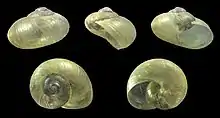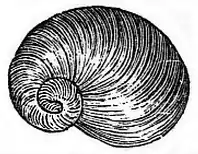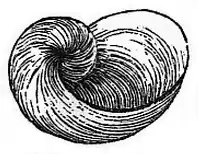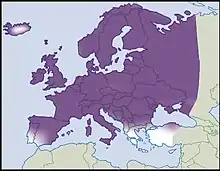Vitrina pellucida
Vitrina pellucida is species of small land snail, a terrestrial pulmonate gastropod mollusk in the family Vitrinidae, the glass snails. [4]
| Western glass-snail[1] | |
|---|---|
 | |
| Shells of Vitrina pellucida | |
| Scientific classification | |
| Domain: | Eukaryota |
| Kingdom: | Animalia |
| Phylum: | Mollusca |
| Class: | Gastropoda |
| Subclass: | Heterobranchia |
| Order: | Stylommatophora |
| Family: | Vitrinidae |
| Subfamily: | Vitrininae |
| Genus: | Vitrina |
| Species: | V. pellucida |
| Binomial name | |
| Vitrina pellucida (O. F. Müller, 1774)[3] | |
| Synonyms | |
| |
Description
This species is a 'semi-slug' with a flattened, globular shell. The animal is pale grey with darker head and tentacles. It is large in comparison with the shell, and cannot completely retreat into it. The shell is subglobose, somewhat smooth, pellucid and greenish hyaline in colour. The shell has 3 whorls that enlarge rapidly and are somewhat convex. The body whorl is wide and a little flattened below. The suture is wrinkled. The aperture is lunately rounded.[5] The umbilicus is very small.[6]
The width of the shell is 6 mm, the height is 3.5 mm.[5]

 Apical view of the shell of Vitrina pellucida. |
 Umbilical view of the shell of Vitrina pellucida. |
Distribution

This species is known to occur in a number of countries and islands in Western Europe and Central Europe, including:
- Bulgaria
- Czech Republic[7]
- Netherlands
- Poland
- Slovakia[7]
- Ukraine[8]
- Great Britain
- Ireland
- and other areas
Ecology
Predators: This snail is eaten by hedgehogs.[5]
Food: This species eats liverworts (Jungermanniaceae) and decayed leaves. It will also eat dead earthworms and horse manure.[5]
Habitat: These snails live in moist and shady places, but are not usually observed until late in the autumn.[5] These snails occur both in natural and modified habitats, such as in meadows and grasslands, in deciduous and coniferous forests, and in wasteground.[9]
Eggs: The eggs are deposited in small heaps, and have a membraneous covering.[5]
Parasites of Vitrina pellucida include:
- Elaphostrongylus spp.[10]
References
This article incorporates public domain text from the reference[5]
- "Vitrina pellucida". Integrated Taxonomic Information System.
- Páll-Gergely, B. (2018) [errata version of 2011 assessment]. "Vitrina pellucida (Europe assessment)". IUCN Red List of Threatened Species. 2011: e.T157025A128448006. Retrieved 15 June 2023.
- Müller O. F. (1774). Vermivm terrestrium et fluviatilium, seu animalium infusoriorum, helminthicorum, et testaceorum, non marinorum, succincta historia. Volumen alterum. - pp. I-XXVI [= 1-36], 1-214, [1-10]. Havniæ & Lipsiæ. (Heineck & Faber).
- MolluscaBase eds. (2023). MolluscaBase. Vitrina pellucida (O. F. Müller, 1774). Accessed through: World Register of Marine Species at: https://www.marinespecies.org/aphia.php?p=taxdetails&id=1002895 on 2023-06-15
- Tryon G. W. (1885). Manual of Conchology; structural and systematic. With illustrations of the species. Second series: Pulmonata. (2)1: 141-143. Plate 30, fig. 12-16.
- Wiese, V. (2014). Die Landschnecken Deutschlands: Finden - Erkennen – Bestimmen. Quelle & Meyer: Wiebelsheim.
- (in Czech) Horsák M., Juřičková L., Beran L., Čejka T. & Dvořák L. (2010). "Komentovaný seznam měkkýšů zjištěných ve volné přírodě České a Slovenské republiky. [Annotated list of mollusc species recorded outdoors in the Czech and Slovak Republics]". Malacologica Bohemoslovaca, Suppl. 1: 1-37. PDF.
- Balashov I. & Gural-Sverlova N. (2012). "An annotated checklist of the terrestrial molluscs of Ukraine". Journal of Conchology 41(1): 91-109.
- Welter-Schultes, F.W. 2012. European non-marine molluscs, a guide for species identification: Bestimmungsbuch für europäische Land- und Süsswassermollusken. Planet Poster Editions: Göttingen.
- Olsson I.-M., Stéen M. & Mann H. (1993). "Gastropod hosts of Elaphostrongylus spp. (Protostrongylidae, Nematoda)". Rangifer 13(1): 53-55. PDF.
- Strøm, H. (1765). Beskrivelse over Norske insecter, forste stykke. Det Trondheimske Selskab Skrifter. 3: 376–439, pl. VI.
- Alten, J. W. von. (1812). Systematische Abhandlung über die Erd- und Flußconchylien welche um Augsburg und der umliegenden Gegend gefunden werden. I-XVI, 1-120, Tab. I-XIV.
- Pollonera, C. (1884). Monografia del genere Vitrina. Atti della R. Accademia delle Scienze di Torino. 19 (3): 322-342, pl. 10.
- Uličný, J. (1883). Bericht über eine neue Varietät von Vitrina pellucida. Malakozoologische Blätter, Kassel, VI N. F., 200–203.
- Koch, C. (1876). Ueber einige Mollusken und Arachniden der Oetzthaler Hochalpen. Zeitschrift des deutschen und oesterreichischen Alpenvereins. 7: 217-220.
- Bank, R. A.; Neubert, E. (2017). Checklist of the land and freshwater Gastropoda of Europe. Last update: July 16th, 2017
- Hausdorf, B. (1995). The Vitrinidae of Turkey, with remarks on the phylogeny of Gallandia(Gastropoda: Stylommatophora). Zoologischer Anzeiger, 234: 63-74.
- Sysoev, A. V. & Schileyko, A. A. (2009). Land snails and slugs of Russia and adjacent countries. Sofia/Moskva (Pensoft). 312 pp., 142 plates.
External links
- Wohlberedt, O. (1911). Zur Molluskenfauna von Bulgarien. Abhandlungen der Naturforschenden Gesellschaft zu Görlitz. 27: 167-234, pl. 1. Görlitz
- Dall, W. H. (1905). Land and fresh water mollusks of Alaska and adjoining regions. in: Alaska. Harriman Alaska Expedition with cooperation of Washington Academy of Sciences. vol. 13: i-vii + 1-171
- Müller, O. F. (1774). Vermium terrestrium et fluviatilium, seu animalium infusorium, Helminthicorum, et testaceorum, non marinorum, succincta historia. vol 2: I-XXXVI, 1-214, 10 unnumbered pages. Havniae et Lipsiae, apud Heineck et Faber, ex officina Molleriana
- Newcomb, W. (1861). Description of new shells. Proceedings of the California Academy of Sciences. (1)2: 91-94
- Pfeiffer, C. (1821-1828). Naturgeschichte deutscher Land- und Süsswasser-Mollusken. Weimar. Abt. 1: i-x, 1-134, pls 1-8
- Boettger, O. (1880). Kaukasische Mollusken gesammelt von Herrn Hans Leder, z. Z. in Tiflis. Jahrbücher der Deutschen Malakozoologischen Gesellschaft. 7 (2): 109-150, pl. 4. Frankfurt am Main
- Kimakowicz, M. von (1890). Beitrag zur Molluskenfauna Siebenbürgens, II. Nachtrag. Verhandlungen und Mittheilungen des Siebenbürgischen Vereins für Naturwissenschaften, 40: 1-113. Hermannstadt
- Gredler, V. M. (1856). Tirols Land- und Süßwasser-Conchylien I. Die Landconchylien. Verhandlungen der Kaiserlich-königlichen Zoologisch-botanischen Gesellschaft in Wien. 6: 25–162. Wien
- Jeffreys, J. G. (1830). A synopsis of the testaceous pneumonobranchous Mollusca of Great Britain. Transactions of the Linnean Society of London. 16: 323-392.
- Brown, T. (1818). Account of the Irish testacea. Memoirs of the Wernerian Natural History. Society. 2(2): 501-536
- Jeffreys, J. G. (1830). A synopsis of the testaceous pneumonobranchous Mollusca of Great Britain. Transactions of the Linnean Society of London. 16: 323-392.
- Westerlund, C. A. (1876). Fauna Europaea Molluscorum Extramarinorum. Prodromus. Sistens descriptiones systematicas et criticas omnium generum et specierum horum animalium in Europa viventium et hodie cognitarum. Fasciculus I. 1-160. Lund (Fr. Berlings)
- Saint-Simon A. de. (1870). Description d´espèces nouvelles du Midi de la France. Annales de Malacologie. 1: 20–33
- Schileyko, A. A. & Rymzhanov, T. S. (2013). Fauna of land mollusks (Gastropoda, Pulmonata Terrestria) of Kazakhstan and adjacent territories. Moscow-Almaty: KMK Scientific Press. 389 pp
- Nevill, G. (1878). Mollusca. Scientific Results of the Second Yarkand Mission; based upon the collections and notes of the late Ferdinand Stoliczka Ph.D., 1-21, 1 pl. Calcutta (Office of the Superintendent of Government Printing).
- Vitrina pellucida at Animalbase taxonomy ,short description, distribution, biology, status (threats), images
